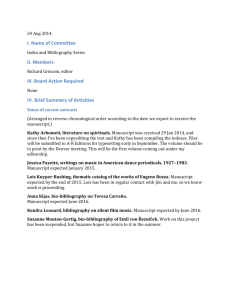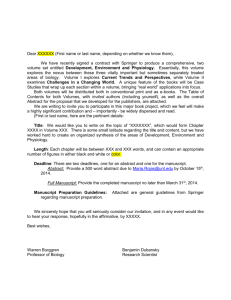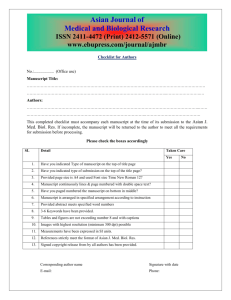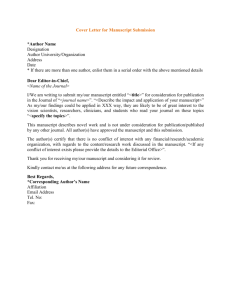version linguistic
advertisement
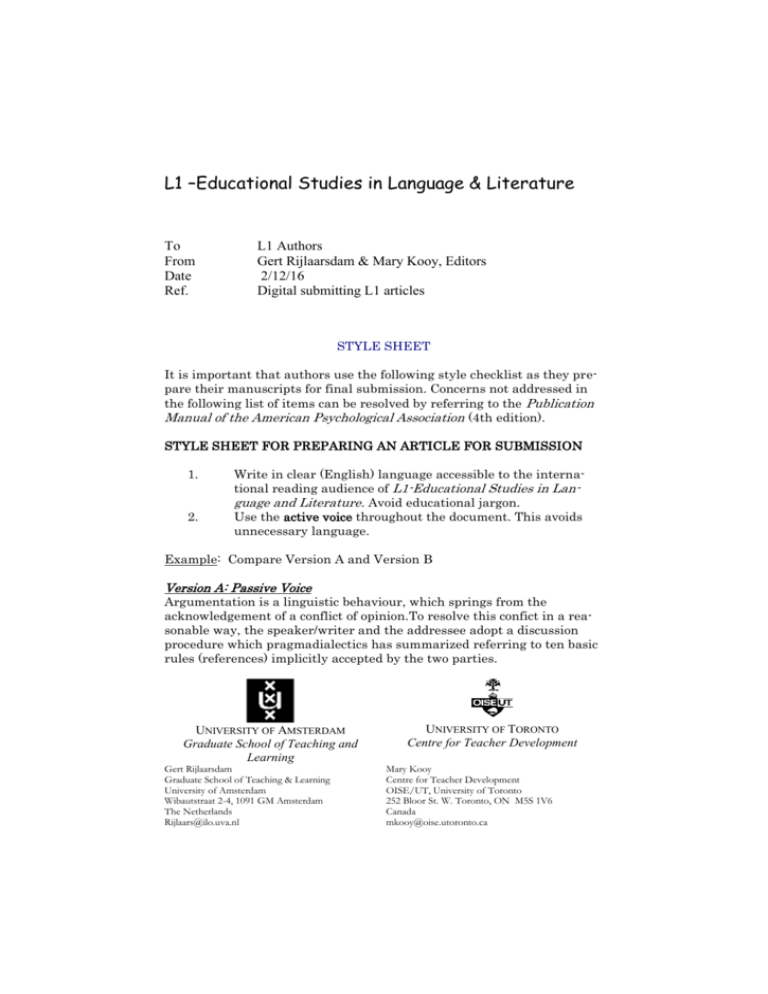
L1 –Educational Studies in Language & Literature To From Date Ref. L1 Authors Gert Rijlaarsdam & Mary Kooy, Editors 2/12/16 Digital submitting L1 articles STYLE SHEET It is important that authors use the following style checklist as they prepare their manuscripts for final submission. Concerns not addressed in the following list of items can be resolved by referring to the Publication Manual of the American Psychological Association (4th edition). STYLE SHEET FOR PREPARING AN ARTICLE FOR SUBMISSION 1. 2. Write in clear (English) language accessible to the international reading audience of L1-Educational Studies in Language and Literature. Avoid educational jargon. Use the active voice throughout the document. This avoids unnecessary language. Example: Compare Version A and Version B Version A: Passive Voice Argumentation is a linguistic behaviour, which springs from the acknowledgement of a conflict of opinion.To resolve this confict in a reasonable way, the speaker/writer and the addressee adopt a discussion procedure which pragmadialectics has summarized referring to ten basic rules (references) implicitly accepted by the two parties. UNIVERSITY OF AMSTERDAM Graduate School of Teaching and Learning Gert Rijlaarsdam Graduate School of Teaching & Learning University of Amsterdam Wibautstraat 2-4, 1091 GM Amsterdam The Netherlands Rijlaars@ilo.uva.nl UNIVERSITY OF TORONTO Centre for Teacher Development Mary Kooy Centre for Teacher Development OISE/UT, University of Toronto 252 Bloor St. W. Toronto, ON M5S 1V6 Canada mkooy@oise.utoronto.ca 2 L1-EDUCATIONAL STUDIES IN LANGUAGE AND LITERATURE Version b: Active Voice Argumentation as a linguistic behaviour arises from a conflict of opinion. To reasonably resolve this conflict, the speaker/writer and the audience adopt a discussion procedure implicitly accepted by the two parties. SUBMITTING AN ONLINE COPY OF THE MANUSCRIPT: Submit a perfectly clean copy of the manuscript online to the L1Educational Studies in Language and Literature website1. A manuscript can contain text and all kinds of other materials (filmclips, video, audio, think aloud protocols, photo’s etc.). Per manuscript, the publication server can upload five files. If your manuscript consists of more files, then upload the other files as a second manuscript as [Part2]. If you need help, contact Gert Rijlaarsdam at G.C.W.Rijlaarsdam@uva.nl. Double-space EVERYTHING, including the title page, bibliographic statements, abstract, author's notes, block quotations, appendixes, tables, endnotes, references. Use 12 pt. font for the final version of the article. Include a word count in the cover letter that accompanies the final version of the article. Indicate emphasis by using italics; do not use bold. Do not right-justify the manuscript. Title Page: Include title and subtitle, running head, authors' names, academic affiliation, and addresses, telephone and fax numbers, as well as email addresses. Abstract: On a separate page, include a short (200 words or fewer) double-spaced abstract of the manuscript. Below the abstract, include about five key words that identify the work of the paper. Article: The article begins on the first page after the abstract page. 1 http://www.ilo.uva.nl/development/L1EducationResearch/default.html PREPARATION OF A CAMERA-READY MANUSCRIPT 3 Footnotes and Endnotes: Avoid using footnotes or endnotes in your manuscript. References: Provide all (and only) citations in the text in the References section. The references section appears at the end of the article, beginning on a separate page, after the text (and notes). Double-space all citations and references and follow APA guidelines for format. If you include reference titles in a language other than English, add, directly next tot the title, a translation of the title into English, between [brackets]. Tables, Figures, Audio- & Videomaterials: Provide all TABLES and FIGURES, each on separate pages, grouped at the end of the manuscript, following the references section. Except for size, all figures should appear exactly as the authors wish them to appear in print. All figures with data must be prepared with MS exel, so that editors can make adjustments if necessary.All Tables and Figures are to be noted within the document as [Insert Table 1 here]. For audio, video and illustrations: these data should be uploaded separately on the L1 Publication server. In the running text, insertions must be indicated like tables and figures as [Insert videoclip [add filename] here. Captions for Tables, Figures, and other materials to be inserted in the text must be delivered at the end of the text on a separate sheet called CAPTIONS. Author’s Note: If desired, provide a brief AUTHOR'S NOTE (indicating acknowledgements, funding sponsors, addresses for correspondence including e-mail). Permissions: Written permission for all tables, figures, or quotations over 500 words and non-written materials from sources for which the author does not hold the copyright, and all quotations of ANY length from newspapers, radio, TV broadcasts, or magazines. Include evidence of permission with the manuscript. Permission must indicate the original author's consent to electronic reproductions of this material. If written permission has not been obtained by the time your manuscript reaches final draft stage, copyrighted materials will be paraphrased or dropped. Mary Kooy & Gert Rijlaarsdam, editors




